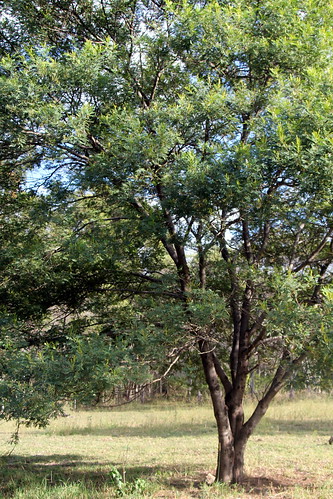| Acacia nilotica ssp. tomentosa (Photo credit: dinesh_valke) |
In size it is a small tree, and in appearance it resembles the white Egyptian Acacia, its leaves are like those of the willow, as it is called, the bloom it bears is in colour like gold, and the frankincense which comes from it oozes forth in drops like tears.
http://www.theoi.com/Phylos/Pankhaia.html
The Egyptian thorn (Photo credit: TREEAID)
But the myrrh-tree is like the mastich-tree, although its leaves are more slender and grow thicker. It oozes myrrh when the earth is dug away from the roots, and if it is planted in fertile soil this take place twice a year, in spring and in summer; the myrrh of the spring is red, because of the dew, but that of the summer is white.
| frankincense tree (Photo credit: Alexbip) |
| Acacia baileyana (Photo credit: Wikipedia) |
ACACIA MELANOXYLON
common names: sally wattle, blackwood
type collected: R Brown, Tas, 1804.
habit: Small to relatively large tree, 8 - 30m.
 |
| Black Sally Wattle up near Tabulam NSW by Eminpee Fotography |
foliage: Variable lanceolate to elliptic phyllodes, 60 - 120mm x 10 - 20mm, 3 - 5 main veins with numerous secondary nerves between and conecting them. Gland small and inconspicuous.
flowers: Creamy yellow ball flowers on racemes, flowers late winter to spring.
pods: Tightly coiled and twisted leathery pods, 50 - 120mm x 5 - 10mm, thickened margins.
seeds: Longitudinal in pod, pinkish aril wraps around seed twice, not toally encircling it.
distribution: Widespread in Sth and E Vic, coast and tablelands of NSW, also SA, Tas and Qld.
notes: Victorian Aborigenes used a hot infusion of the roasted bark to bathe rheumatic joints. Bark and twigs used as a fish poison.
Fine timber, used in cabinet and ornamental work, once used in coach and boat building, also for beer barrels, regarded as the best Australian timber for this.
Young phyllodes have given a positive test for alkaloids. (references: 1, 2, 15)
Here is a complete reference list of the acacia here in Australia.
References to uses and properties of acacias
- Australian medicinal plants, E V Lassak & T McCarthy, Methuen Aust, 1985
- Useful wild plants in Australia, A & J Cribb, Fontana/ Collins, 1982
- Wild food in Australia, A & J Cribb, Fontana/ Collins, 1987
- Mutooroo- plant use by Aboriginal people, G Leiper, Assembly press, 1985
- Wild food plants of Australia, T Low, Angus & Robertson, 1992
- Bush tucker; Australia's wild food harvest, T Low, Angus & Robertson, 1991
- Poisonous plants of Australia, S Everist, Angus & Robertson, 1981
- Wild medicine in Australia, A & J Cribb, Fontana/ Collins, 1981
- Bush food: Aboriginal food and herbal medicine, J Isaacs, Weldons publishign, 1987
- Plants and people: Aboriginal uses of plants on groote eylandt, D Levitt, Aust inst of Aboriginal studies, Canberra, 1981
- Examination of acacia species for alkaloids, E White, NZ J. Sci. & Tech., July 1957, p 718.
- Alkaloids of the Aust. leguminosae, J Fitzgerald & A Sioumis, Aust. J. Chem., #18:433-4, 1965
- Alkaloids of acacia, B Rovelli & G Vaugan, Aust. J. Chem., #20:1299-1300, 1967
- Traditional bush medicine; an Aboriginal pharmacopeia, Nth. Territory Govt, 1990
- Plants for medicines; a chemical and pharmacological survey of plants in the Aust. region, CSIRO, 1990
- N-methyl-tetrahydroharman from acacia complanata, Johns, Lamberton & Sioumis, Aust J. Chem., #19:1539-40, 1966
- Alkaloids of acacia baileyana, Repke & Mandell, Lloydia #36/2:211-13, 1973
- Fijian medicinal plants, R Cambie & J Ash, CSIRO, 1994
- Wattle, M Hitchcock, Aust Gov. printer, 1991
- Acacias of Sth Australia, Whibley & Symon, SA Gov printer, 1992
- Bushfires and Bushtucker, Aboriginal plant use in central Australia, P. Latz, IAD press, 1995.

No comments:
Post a Comment